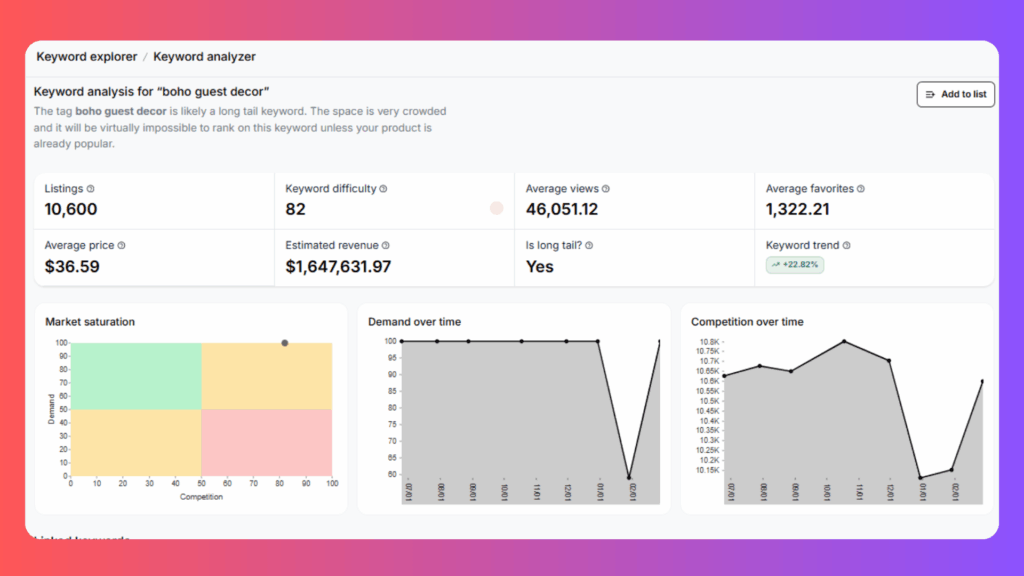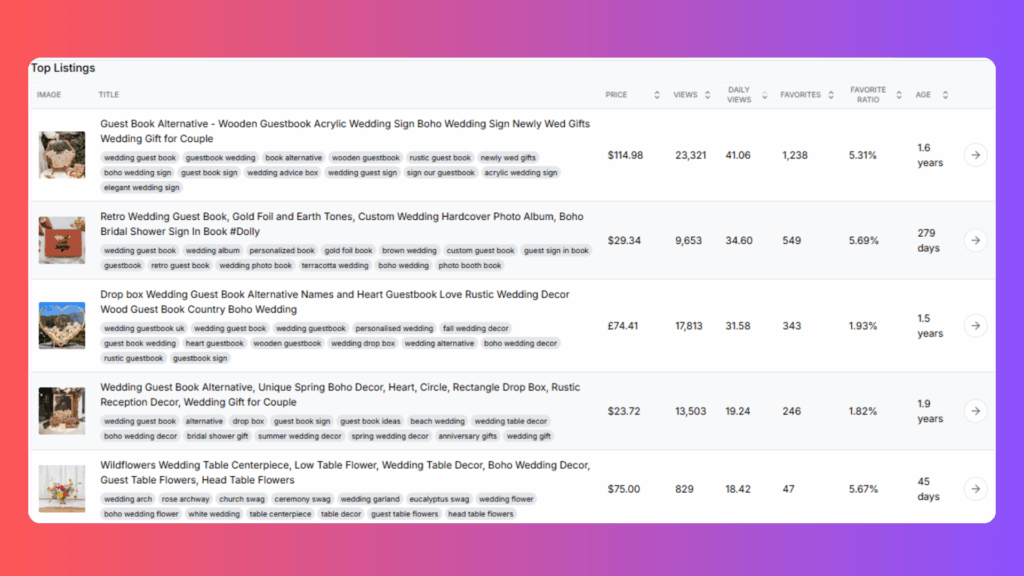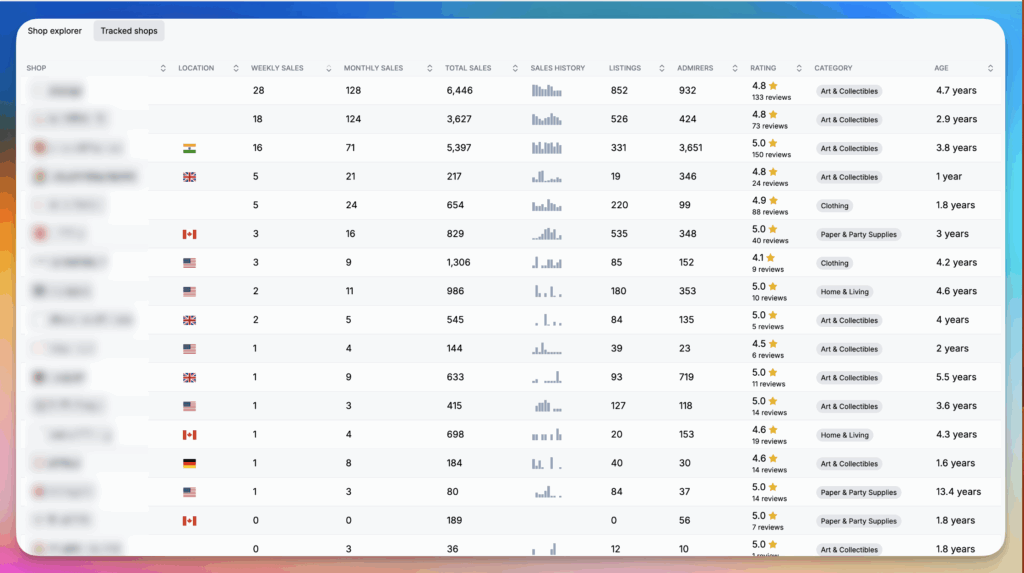Whether you have a niche product or an evergreen one, if your shop is successful, you must watch your competition. Oftentimes, the reason for a drop in sales is the rise of competitors that are trying to sell similar products to other successful shops. Maybe they are filling a gap in your product offering or just trying to get a piece of the pie. In this article, we will learn:
- How do you find your competitors?
- How do you evaluate the completion?
- How do you track your competitors?
How do you find your competitors?
First, understand your niche. Use Etsy search to look for shops in similar niches and make a list of all the shops that are selling items that fall under your niche. Usually, going through the top 5-8 pages is enough. Pick shops that have a decent number of reviews because it indicates that they are making sales on Etsy.
If instead of a niche, you want to find out competitors trying to copy and sell top seller listing. You would search Etsy for keywords that describe your listing and repeat the process.
This should give you a list of the top 10-20 shops that are your competitors. The process will be the same if you are trying to launch a new product and want to analyze the existing competitive landscape.
Now, for each shop,
- Note their sales
- Number of reviews
- Number of listings
- How similar or different are their product to yours?
- Understand their price range
- Go through their reviews to see which products have more reviews. This indicates the sales pattern of their listings. The more sales a listing makes, the more reviews it will have.
- Understand which listings are being promoted by Etsy.
Out of this list of 10-20 shops, pick the top 5 competitors. You can always analyze the rest later, but it is better to identify your true competitors before you do a deeper dive in analyzing them.
How do you evaluate the completion?
Now you have a list of top five competitors, and its time to perform a through analysis of their strategy, metrics, and shop patterns.
Here are a few of them.
Favorite and Favorite ratio, what’s the difference?
- Favorite is the number of how many people have liked the product and added the listing to their favorites
- Favorite ratio = (Number of People Who Added to Favorites ÷ Number of Views) x 100
You probably want to take “favorites” as an indication of desirability and “favorite ratio” as a metric to optimize for. For example: If someone brings a lot of views through ads and external traffic, but they don’t engage with your listing, then it’s probably not the best strategy.
Understanding listing patterns
Keep an eye on how often your competitors update their keywords. Etsy’s algorithm favors fresh and relevant terms. Reverse engineer this strategy by searching for their product name and seeing how high it ranks on Etsy’s search results each week.
Quality of photos
- Pay attention to how products are displayed.
- Are they just thrown on a table with bad lighting, or are they showcased properly?
- For example, with jewelry
- Are there close-up shots?
- Are there different angles?
- Are they showing it on a model?
- Are there proper product dimensions and videos?
Pricing strategies
- Don’t just go cheap on your prices, study what pricing works best in your niche.
- See if competitors are offering free shipping or discounts around specific occasions.
- If a product has high daily views and a good favorite ratio but low conversions,
- Consider selling a similar product with better pricing.
- Offer bundles to increase perceived value.
Spotting Etsy trends
When it come to understanding Etsy trends, daily views (and overall views for listing’s past performance) on the product might be a good indicator of what’s being promoted on Etsy, however you will have to analyze if the same thing is being sold as well.
- Understand the difference between what’s trending vs. what’s selling.
- Sometimes, old listings (5+ years) randomly trend, this can signal a seasonal trend returning.
Estimating a competitor’s conversion rate
- There’s no direct conversion rate column for competitor shops (unlike in your own shop manager).
- Calculate approximate conversion percentage:
- (Number of sales this week ÷ Number of views this week) × 100
- Keep in mind, that conversion rates alone don’t tell the full story. You need to look at it holistically to understand overall shop performance. So stay updated on the numbers! (yours and your favorite shop’s)
How to utilize Listadum tools to help you in your research?
Etsy marketplace is not just about making great products but also understanding your niche!
This can be challenging without spending hours on market research and trend identification.
To keep up to date with your niche, you need to:
- Monitor competition that can dilute your offering. (maybe those sales have slowed down)
- Other products that spawned out of your existing niche and are selling. (niche + niche = new niche)
- Expand your shop to offer more products that fall within your craft and skill set.
- Find shops that are copying your products and selling more than you. (You probably need a strategy refresh)
- Find a list of shops that inspire you to be better. (Your feel-good and dreamer board)
Here are a few tools that can help you navigate these challenges:
Keyword explorer
- Using a combination of Keyword explorer, Etsy search and Listadum extension, find the keywords trending in your niche, and reverse engineer it to find product inspirations.
- For each keyword, run the analysis on Listadum using the search bar. This page will show you if the keyword is in demand or not and the competition. Typically if it falls in the green zone, it’s a good indication of a trending product niche.

- Now that you have your keyword search for it in Keyword Explorer and scroll down to bottom where you can see top listings using that keyword. Analyze those listings, look up the shops and see if they fit your competitor criteria (i.e. consistent sales, good reviews).

- TRACK THE SHOPS THAT CATCH YOUR ATTENTION.Listadum allows you to create a list of your competitors and monitor them closely. This is a how a typical Competition list looks like:

- By monitoring your competition or industry trends, you can stay ahead of the game by keeping your shop up to date. It is always a good idea to understand the consumer patterns in your product category and analyze any possible opportunities. With Listadum’s Shop Explorer, you can make data-driven decisions effortlessly, whether it’s optimizing your pricing, identifying market gaps, or tracking top-performing competitors.
Hopefully, this guide has helped you understand how to perform a thorough competitive analysis effectively. If you have any questions, feel free to reach out to us in our Discord community, via chat, or by email.
Listadum is here to help you grow!